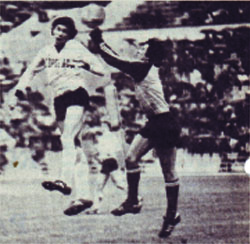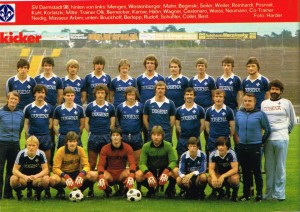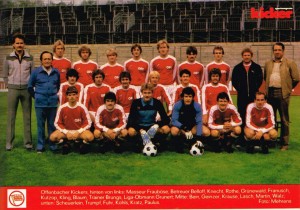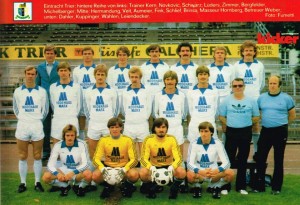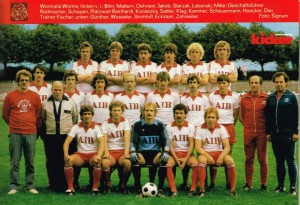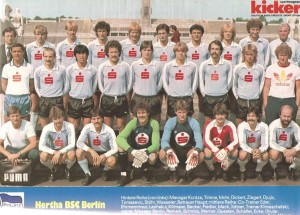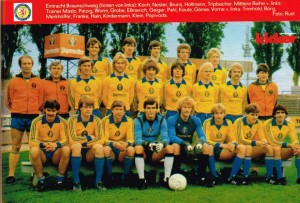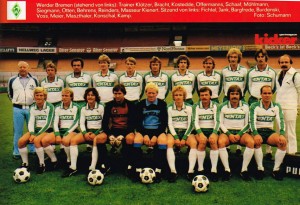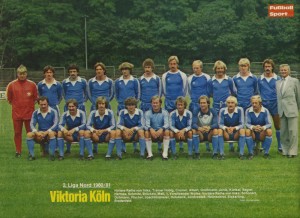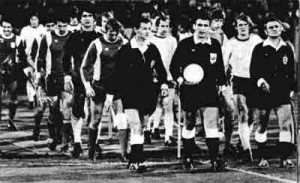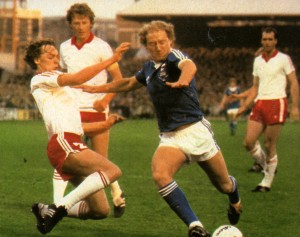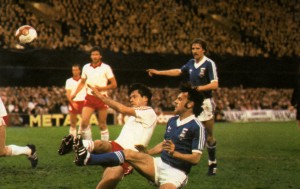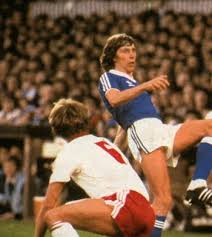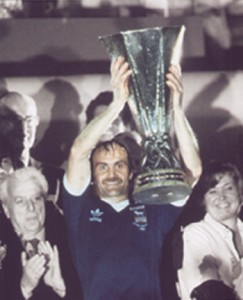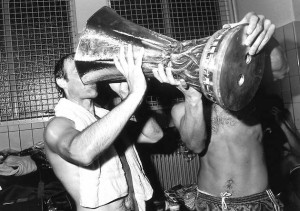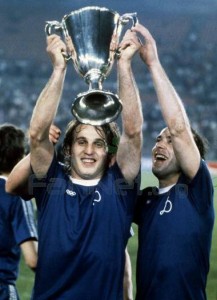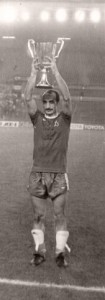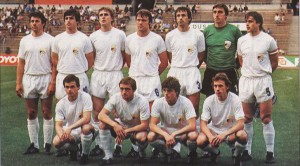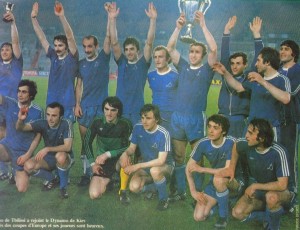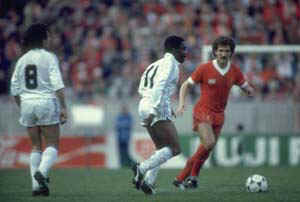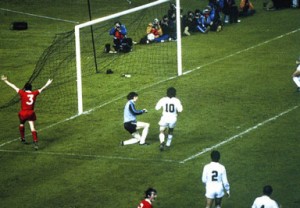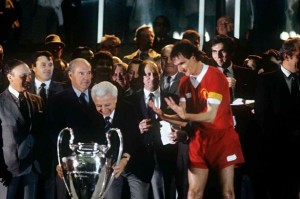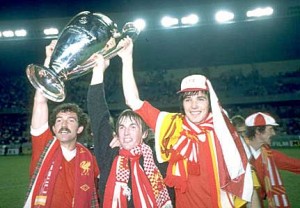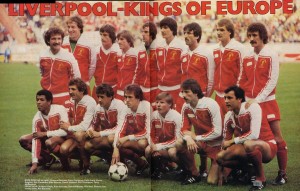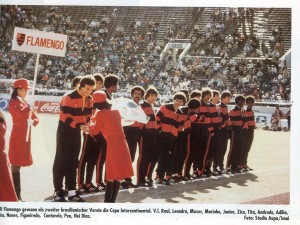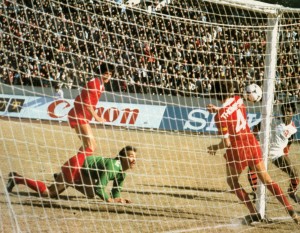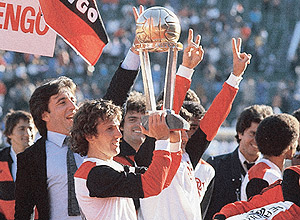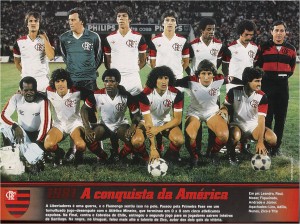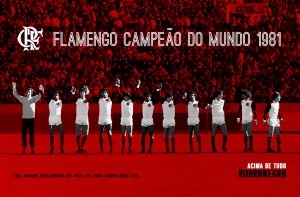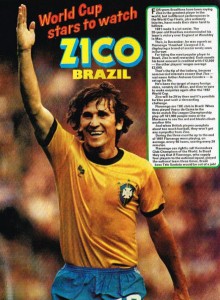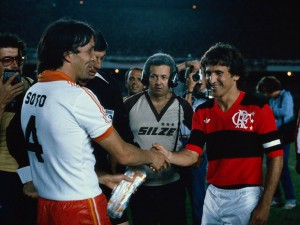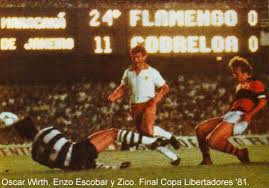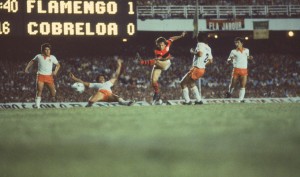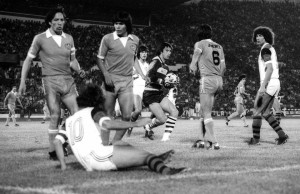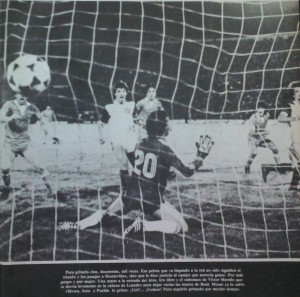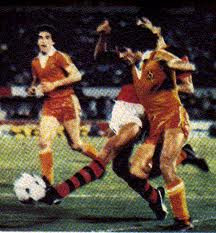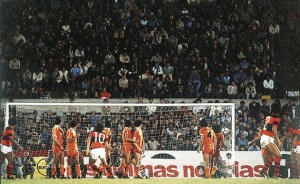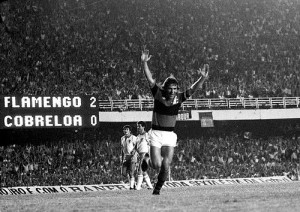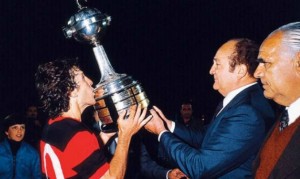The Bundesliga was still number one in Europe, but there were some changes detected: the threat to German superiority came from different directions. English clubs were seemingly stronger on international stage, Spain was buying better foreign players, and with the opening of the Italian market frugal German clubs had little chance of competing for top level foreign stars. At the same time German football became too physical and thus less attractive, bringing some cynicism to the game – winning, no matter how, was all that mattered. Yet German football was still the best.
Not at the bottom of the Bundesliga, of course. Seven clubs tried to escape relegation, some were ‘the usual suspects’, some were unexpected outsiders. Eventually 4 of them survived: MSV Duisburg finished 12th, Fortuna (Dusseldorf), going down after a number of strong years, ended 13th, 1. FC Nurnberg was lucky to stay in the league – 14th, and the same applies to Arminia (Bielefeld) – 15th.
 TSV 1860 (Munchen) was perhaps unlucky to end 16th and relegated, but they finished one point behind Arminia and, more importantly, the club faded during the 1970s and joined the group of so-so clubs too strong for second division and too weak for top flight. Going down was hardly a surprise and apart from leaving the Bundesliga once again without local derby, the only interesting thing about this squad was Rudi Voller – young and not yet noticed talented striker. Of course, today everybody knows his name, but his fame was still in the future – presently, he was going to taste second division football.
TSV 1860 (Munchen) was perhaps unlucky to end 16th and relegated, but they finished one point behind Arminia and, more importantly, the club faded during the 1970s and joined the group of so-so clubs too strong for second division and too weak for top flight. Going down was hardly a surprise and apart from leaving the Bundesliga once again without local derby, the only interesting thing about this squad was Rudi Voller – young and not yet noticed talented striker. Of course, today everybody knows his name, but his fame was still in the future – presently, he was going to taste second division football.
The last in the table was not a surprise either, especially because they dropped out of the race for survival early and finished with just 22 points.
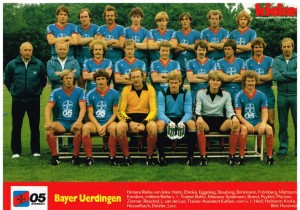 Bayer (Uerdingen) already were among the so-so clubs, although of the two ‘aspirins’, belonging to Bayer, they were the stronger club at first and so far had bigger presence than Leverkusen in the Bundesliga. But it was only statistical superiority – the reality was different and clearly Uerdingen was not going to be impressive club, but the opposite. Nothing unusual they finished last.
Bayer (Uerdingen) already were among the so-so clubs, although of the two ‘aspirins’, belonging to Bayer, they were the stronger club at first and so far had bigger presence than Leverkusen in the Bundesliga. But it was only statistical superiority – the reality was different and clearly Uerdingen was not going to be impressive club, but the opposite. Nothing unusual they finished last.
If two of the relegated teams were expected outsiders, the third one was unpleasant surprise. True, Schalke 04 was going down since their unfortunate involvement in the bribing scandal of the early 1970s, but this was old, successful, popular club – not one to sunk that low, but they did, finishing 17th and like Bayer (Uerdingen), even throwing down the gloves at some time of the championship – Schalke 04 ended with just a point more than Bayer, the worst attack and the worst defense in the league.
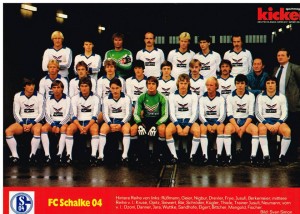 It could have been wrong coach – the 1960s Yugoslavian star Jusufi never became a great coach – but if so, it was just the last drop in the bucket. Schalke 04 was far cry from the exciting team they were less than 10 years ago and to this very day they depended on players from that old team – players, who already too old to keep the club afloat. Fischer, Russmann, and Nigbur – the old guard was just too old by now. So were additions like Danner and Beer – their best days were already gone. So were the foreign stars, recruited recently – the former Yugoslav national team player Vilson Dzoni and the Austrian winger Kurt Jara. Both were at their prime years ago, around 1974, and now the calendar said 1980. After Werder (Bremen), another original member of the Bundesliga went down – name itself was not a guarantee for staying among the best and the the number of original members of the league was reduced to 5 clubs.
It could have been wrong coach – the 1960s Yugoslavian star Jusufi never became a great coach – but if so, it was just the last drop in the bucket. Schalke 04 was far cry from the exciting team they were less than 10 years ago and to this very day they depended on players from that old team – players, who already too old to keep the club afloat. Fischer, Russmann, and Nigbur – the old guard was just too old by now. So were additions like Danner and Beer – their best days were already gone. So were the foreign stars, recruited recently – the former Yugoslav national team player Vilson Dzoni and the Austrian winger Kurt Jara. Both were at their prime years ago, around 1974, and now the calendar said 1980. After Werder (Bremen), another original member of the Bundesliga went down – name itself was not a guarantee for staying among the best and the the number of original members of the league was reduced to 5 clubs.
Across the league – different fates, but regress was observed in Fortuna (Dusseldorf).
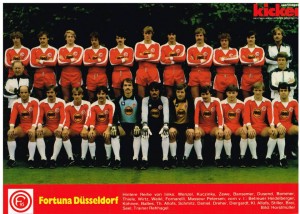 Fortuna was one of the strongest German clubs during the 1970s and only two years ago was expected to become one of the main favourites. But progress halted – the team was not getting better, just the opposite. Otto Reghagel coached Fortuna in 1980-81, but the young then coach hardly improved the team: it was based on getting too old stars Seel and Zewe, local heroes, also beyond their prime, Baltes and Daniel, and the Alofs brothers, who were certainly to be among the big stars of the 1980s, but unable to improve Fortuna. The team finished 13th this season.
Fortuna was one of the strongest German clubs during the 1970s and only two years ago was expected to become one of the main favourites. But progress halted – the team was not getting better, just the opposite. Otto Reghagel coached Fortuna in 1980-81, but the young then coach hardly improved the team: it was based on getting too old stars Seel and Zewe, local heroes, also beyond their prime, Baltes and Daniel, and the Alofs brothers, who were certainly to be among the big stars of the 1980s, but unable to improve Fortuna. The team finished 13th this season.
In the opposite direction was going Borussia (Dortmund), which had miserable 1970s.
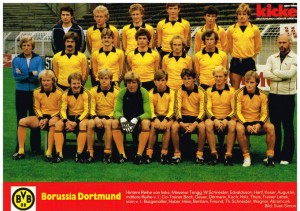 Under Udo Lattek, bearded by now, Borussia finished 7th this year, but the future looked very optimistic, for the squad was good – Geyer, Burgsmuller, Abramczik, Freund, and the Islandic import Edvaldsson were more than strong backbone and perhaps with few talented additions Borussia would be able to compete for the title.
Under Udo Lattek, bearded by now, Borussia finished 7th this year, but the future looked very optimistic, for the squad was good – Geyer, Burgsmuller, Abramczik, Freund, and the Islandic import Edvaldsson were more than strong backbone and perhaps with few talented additions Borussia would be able to compete for the title.
For the moment, 4 clubs competed for it: 1. FC Kaiserslautern, VfB Stuttgart, Hamburger SV, and Bayern. During the championship the group broke down to two pairs – Kaiserslautern and Stuttgart fought for the bronze medals and HSV and Bayern – for the gold.
 At the end, Kaiserslautern was 4th. It was fair finish: unstable, one year up the next down, Kaiserslautern had a strong season and the players to keep it on top – Geye, Bongartz, Hellstrom, Pirrung, Wendt, and the new bright star Briegel. They also had a talented coach – Feldkamp. But the squad was weaker than the opposition and with the exception of Briegel and may be the Austrin Riedl, the key figures were old news, already going downhill. Small consolation – Kaiserslautern finished with the best defensive record in the league.
At the end, Kaiserslautern was 4th. It was fair finish: unstable, one year up the next down, Kaiserslautern had a strong season and the players to keep it on top – Geye, Bongartz, Hellstrom, Pirrung, Wendt, and the new bright star Briegel. They also had a talented coach – Feldkamp. But the squad was weaker than the opposition and with the exception of Briegel and may be the Austrin Riedl, the key figures were old news, already going downhill. Small consolation – Kaiserslautern finished with the best defensive record in the league.
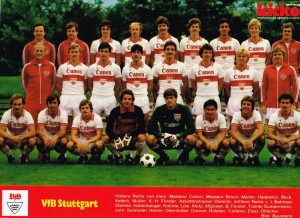 Stuttgart bested Kaiserslautern by 2 points. Bright team, steadily climbing up, but not yet at its peak. The veterans were foreign – the Yugoslavian Holcer and the Austrian Hattenberger – but their roles were no longer central: Stuttgart was lead by group of players already recognized for stars and certainly the names of 1980s football: Hansi Muller and the Forster brothers. Add Ohlicher, Allgower, and Roleder. Hidden in the squad and hardly noticed by anyone was a player who never became a star, but made Germany World champion in 2014 – Low.
Stuttgart bested Kaiserslautern by 2 points. Bright team, steadily climbing up, but not yet at its peak. The veterans were foreign – the Yugoslavian Holcer and the Austrian Hattenberger – but their roles were no longer central: Stuttgart was lead by group of players already recognized for stars and certainly the names of 1980s football: Hansi Muller and the Forster brothers. Add Ohlicher, Allgower, and Roleder. Hidden in the squad and hardly noticed by anyone was a player who never became a star, but made Germany World champion in 2014 – Low.
Hamburger SV and Bayern raced for the title and at the end Bayern prevailed, leaving HSV 4 points behind.
 Hamburger lost and it was not a matter of class – it was just not their year. Kevin Keegan was no longer with the club, but the squad was excellent – Magath, Kaltz, Hrubesch, Buljan were the world class leaders of the team, followed by plethora of younger talent – Stein, von Heesen, Jakobs, Hieronymus, Hartwig, Milewski, Groh, Wehmeyer. Three veterans of the beginning of the rise in 1975 were still here, just in case – Reimann, Hidien, and Memering. And after Happel another great coach was at the helm – Branko Zebec. Second place was disappointing, but only for the moment – the team was great and going to stay as leading German club. And not only German leader.
Hamburger lost and it was not a matter of class – it was just not their year. Kevin Keegan was no longer with the club, but the squad was excellent – Magath, Kaltz, Hrubesch, Buljan were the world class leaders of the team, followed by plethora of younger talent – Stein, von Heesen, Jakobs, Hieronymus, Hartwig, Milewski, Groh, Wehmeyer. Three veterans of the beginning of the rise in 1975 were still here, just in case – Reimann, Hidien, and Memering. And after Happel another great coach was at the helm – Branko Zebec. Second place was disappointing, but only for the moment – the team was great and going to stay as leading German club. And not only German leader.
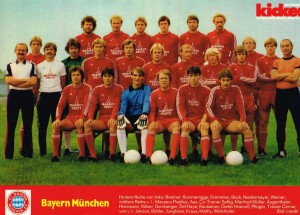 Bayern – champion, nothing new. But this title was significant because the new Bayern was firmly established – after a full remake, Bayern had new great team thanks to Pal Cernai. An Yugoslav made the first great Bayern and Hungarian – the second. But it was not at all similar to the first: the old one was made from scratch; the second one was actually built on the ashes of the first one. Paul Breitner was the heart of the team, with Karl-Heinz Rummenigge the second leader. Breitner was part of the first successful Bayern, Rummenigge played with the giants when they neared the end. Both were practically from the old days and along with them were few others – Durnberger, Horsmann, and Kraus . Second-rate players, once upon a time just reserves with little chance for playing (Kraus), or inconsistant (Horsmann). Durnberger was the unsung hero of the old guard – not a great player, but sturdy and dependable, who not only ready to plug any holes, no matter the position, but was important part of the winning team. The rest of the new team was a mixed bag of no longer young talented players, who made their names elsewhere – Del’Haye and Janzon, late discoveries – Dieter Muller, and young talent, still too young to be consistent – Dremmler, Augenthaler, Mathy, Pgluger. This was entirely German squad, unlike the first great Bayern, which always had at least one foreigner among the regulars – now the only import was a deep reserve from Finland – Rautainen. The team was strong, but without much flair – it depended on strength and determination, and on physical superiority. Creativity was left entirely to Breitner and Rummenigge was expected to score the goals. Which he did, promptly finishing as top league scorer for a second consecutive year. If there was a weak spot, it was between the goalposts: of course, it was very difficult to find acceptable goalkeeper after Sepp Maier, but so far Bayern was unable to get a strong one. Junghans and Manfred Muller shared the goalkeeping duties for now, but neither was good enough and Bayern not only was looking in need of strong goalkeeper, but they were looking for one. As a whole, not as great as the first Bayern was, but who could blame champions?
Bayern – champion, nothing new. But this title was significant because the new Bayern was firmly established – after a full remake, Bayern had new great team thanks to Pal Cernai. An Yugoslav made the first great Bayern and Hungarian – the second. But it was not at all similar to the first: the old one was made from scratch; the second one was actually built on the ashes of the first one. Paul Breitner was the heart of the team, with Karl-Heinz Rummenigge the second leader. Breitner was part of the first successful Bayern, Rummenigge played with the giants when they neared the end. Both were practically from the old days and along with them were few others – Durnberger, Horsmann, and Kraus . Second-rate players, once upon a time just reserves with little chance for playing (Kraus), or inconsistant (Horsmann). Durnberger was the unsung hero of the old guard – not a great player, but sturdy and dependable, who not only ready to plug any holes, no matter the position, but was important part of the winning team. The rest of the new team was a mixed bag of no longer young talented players, who made their names elsewhere – Del’Haye and Janzon, late discoveries – Dieter Muller, and young talent, still too young to be consistent – Dremmler, Augenthaler, Mathy, Pgluger. This was entirely German squad, unlike the first great Bayern, which always had at least one foreigner among the regulars – now the only import was a deep reserve from Finland – Rautainen. The team was strong, but without much flair – it depended on strength and determination, and on physical superiority. Creativity was left entirely to Breitner and Rummenigge was expected to score the goals. Which he did, promptly finishing as top league scorer for a second consecutive year. If there was a weak spot, it was between the goalposts: of course, it was very difficult to find acceptable goalkeeper after Sepp Maier, but so far Bayern was unable to get a strong one. Junghans and Manfred Muller shared the goalkeeping duties for now, but neither was good enough and Bayern not only was looking in need of strong goalkeeper, but they were looking for one. As a whole, not as great as the first Bayern was, but who could blame champions?
 Casually looking champions – winners looking so confident were surely at the top of the world and going to stay there. Were they really? So far – 7 titles.
Casually looking champions – winners looking so confident were surely at the top of the world and going to stay there. Were they really? So far – 7 titles.
